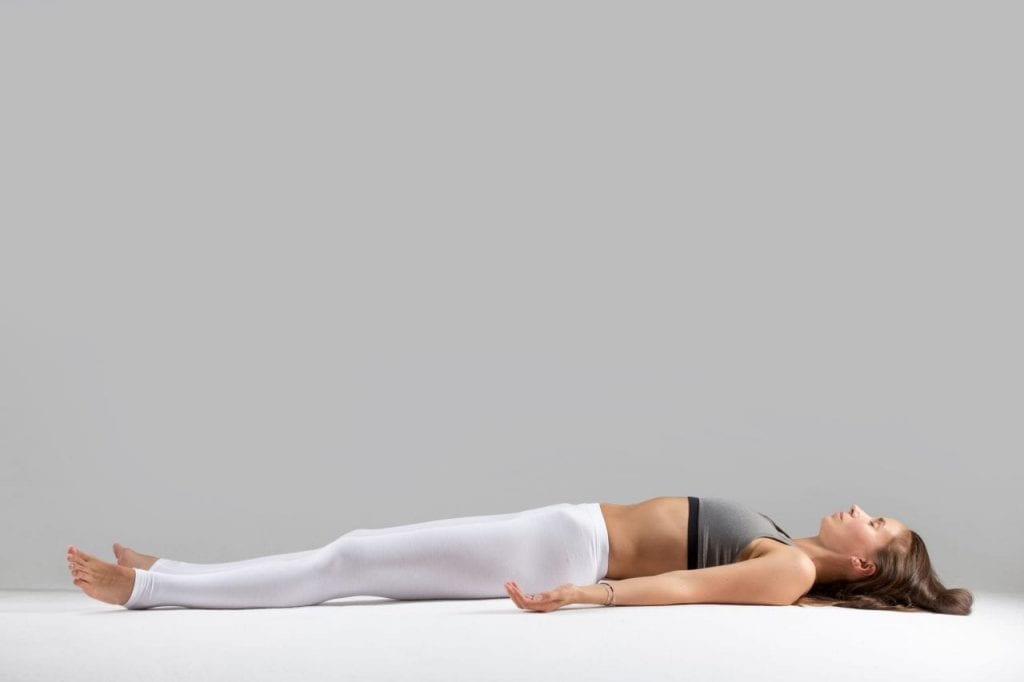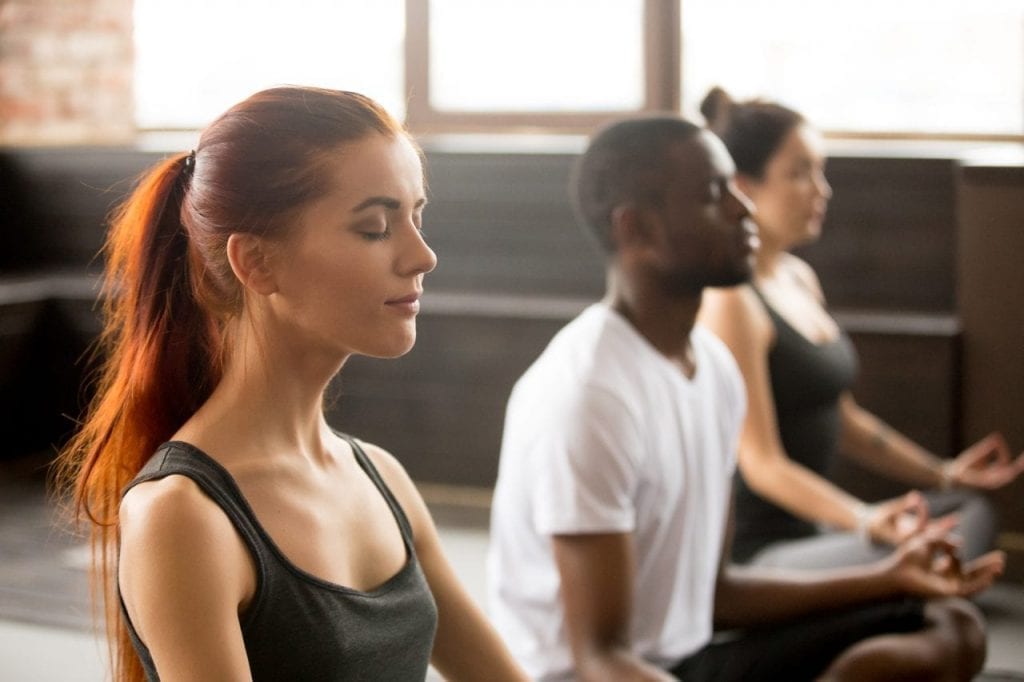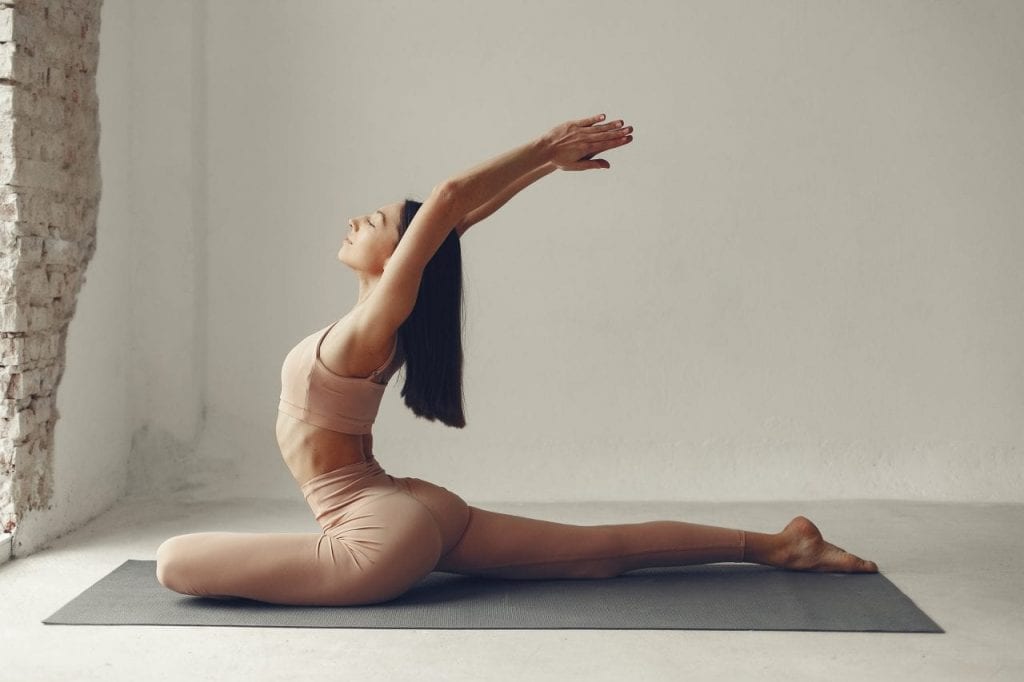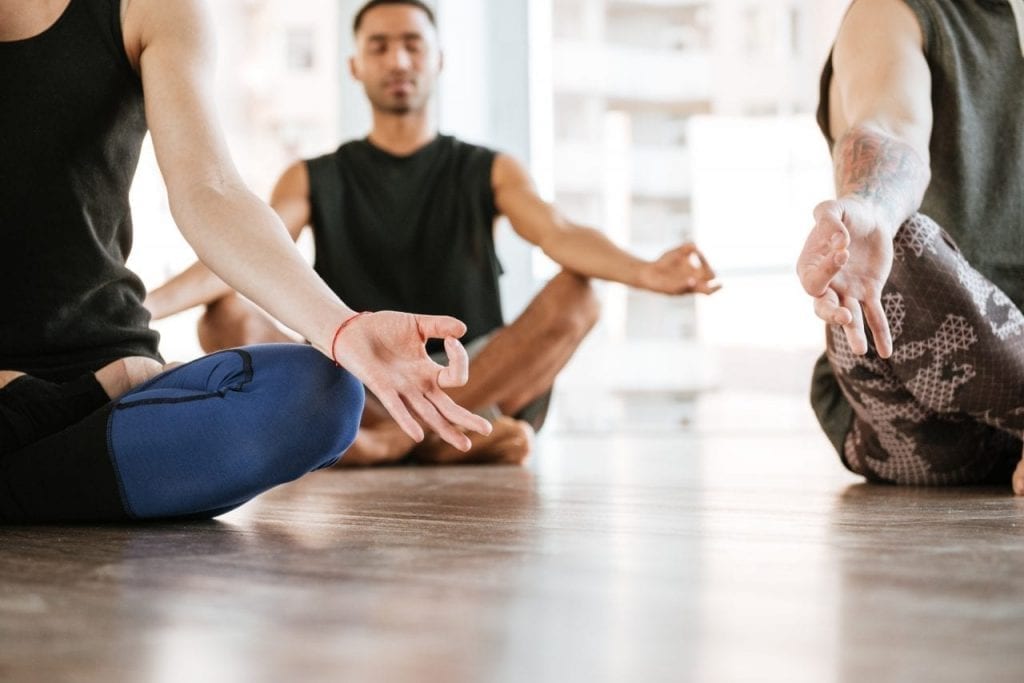If you want to get started in the world of yoga, there are certain postures that are essential for you to learn quickly and comfortably, both to practice in a class and to practice at home.
Tips fot getting started in yoga
Keep in mind that postures aren’t better because they’re more complicated to perform. The important aspect is to take care of the technique and focus your mind on the execution.
Don’t worry if you find it difficult to follow the instructions at first. Over time your body will gain flexibility and balance and your mind will be able to concentrate more easily.
Focus on breathing. It is a fundamental aspect for the correct execution of asanas. Feel the air enter your body through your inhalations and how it comes out when you exhale. You will be surprised by the sensations that you experience.
It is important that you create a habit in your yoga routine, so it is advisable that you have a quiet space to perform your yoga exercises and set a schedule that allows you to perform them without stress and without haste.
Ideally, practice should be done for 30-35 minutes every day of the week. If it’s complicated, do it at least 3 days a week. In a few weeks, you’ll see the results, both physically and mentally.
Wear comfortable clothes that allow you to move easily, but not too loose. Avoid wearing accessories such as rings, pendants, watches or any objects that may annoy or distract you during the yoga session.
It’s time to start. Enjoy your yoga session!
Ten yoga poses for beginners
It's not easy to select 10 yoga poses from more than 300 asanas that exist, but this selection will allow you to start comfortably in practicing yoga, with incredible results
1. Mountain posture (Tadasana)
Benefits:
It may seem that this posture requires you to just stand, but this asana helps you improve posture, balance and calm. This posture is essential for yoga beginners because the alignment, muscle movements and concentration you learn in Tadasana are applied in all standing poses in yoga. Therefore, it is important to learn how to do it correctly.
This posture strengthens the thighs, knees, ankles, abdomen, and buttocks. It is also useful for relieving sciatica and reducing the effects of flat feet. Practicing mountain posture with constant, gentle breathing will help relieve stress and improve your concentration.
Instrucciones
- Stand, with your feet together, spreading the weight of your body evenly and your arms relaxed on the sides with your palms facing forward. Put all your attention on your body.
- Press your toes on the ground. Lift them up and separate them. Then back to rest on the ground. If you find it difficult to maintain balance, you can separate your ankles, keeping your feet parallel
- Stretch your legs, pressing evenly on the floor with your heels and toes. Notice how your body connects to the earth around the four corners of your feet.
- Then lift the ankles and arches of the feet. Squeeze your pimples on each other.
- Stretch the top of your thighs up and down, exercising your quadriceps. Rotate your thighs slightly inwards, opening your hip.
- Slightly turn the tailbone, but without bending the lower back, keeping your hips aligned with your body.
- While inhaling, lengthen your torso. Exhale and release your shoulder blades by separating them from your head, towards the back of your waist.
- Keep your arms straight, your fingers outstretched, and your triceps firm. Turn your arms slightly out.
- Stretch your neck, taking care that your shoulders, hips and ankles are aligned.
- Hold a smooth and even breath. With each exhalation, feel your spine lengthen. Stay in this position for a minute.
2. Dog position face down (Adho mukha svanasana)
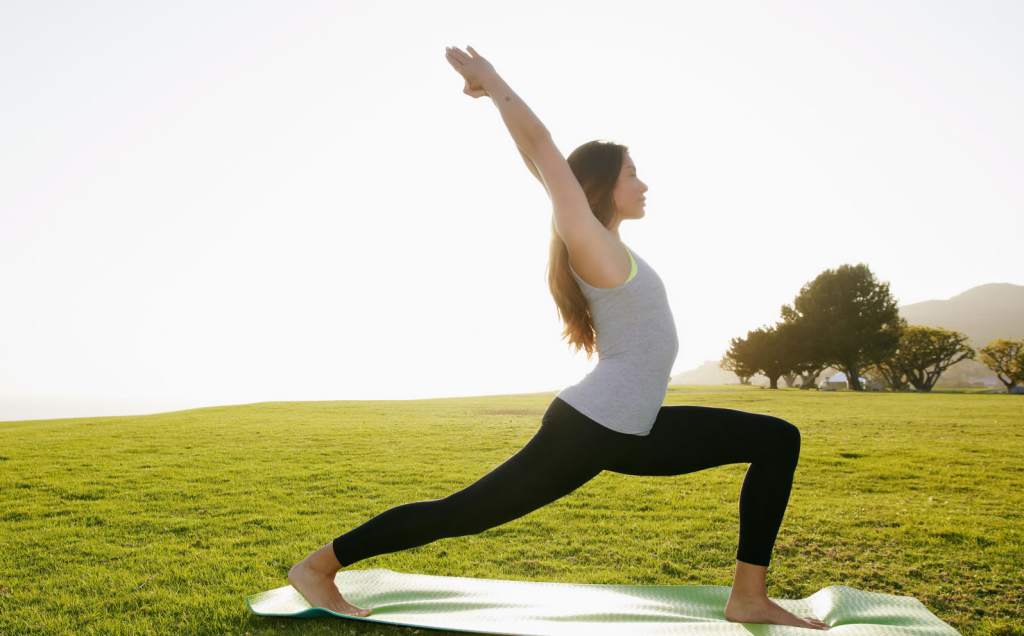
Benefits:
This posture energizes and rejuvenates your entire body. Stretch your hamstrings, shoulders, calves, hands, and spine, while strengthening your arms, shoulders, and legs.
Because in the dog’s face-down posture, the heart is placed above the head, it is considered a mild investment and has all the benefits: relief from headaches, insomnia, fatigue and mild depression. Blood flow to the brain also calms the nervous system, improves memory and concentration and relieves stress.
Regular practice of this posture can improve digestion, relieve back pain and help prevent osteoporosis. It is also known to be therapeutic for sinusitis, asthma, flat feet and menopause symptoms
Instructions
- You can start on your knees, sitting on your heels.
- Stretch your arms forward, sliding the palms of your hand over the mat.
- Extend your fingers and press firmly on the ground with your palms and knuckles. Distribute weight evenly in your hands.
- Then, as you exhale, rest your toes on the ground and lift your hips back, bending your legs.
- Carry the weight towards your feet and gradually see stretching your legs, first one and then the other, several times, trying to bring the heel onto the ground.
- Now, stretch both legs at once, keep your buttocks facing the ceiling and neck relaxed. If you can’t fully stretch your legs, keep them a little bent, but without throwing your body forward.
- Support all your weight towards your feet, stretching your back.
- Hold posture for at least 5 breaths. Focus on breathing.
- To finish, exhale as you gently bend your knees and return to the starting position
3. Table position (Phalakasana)
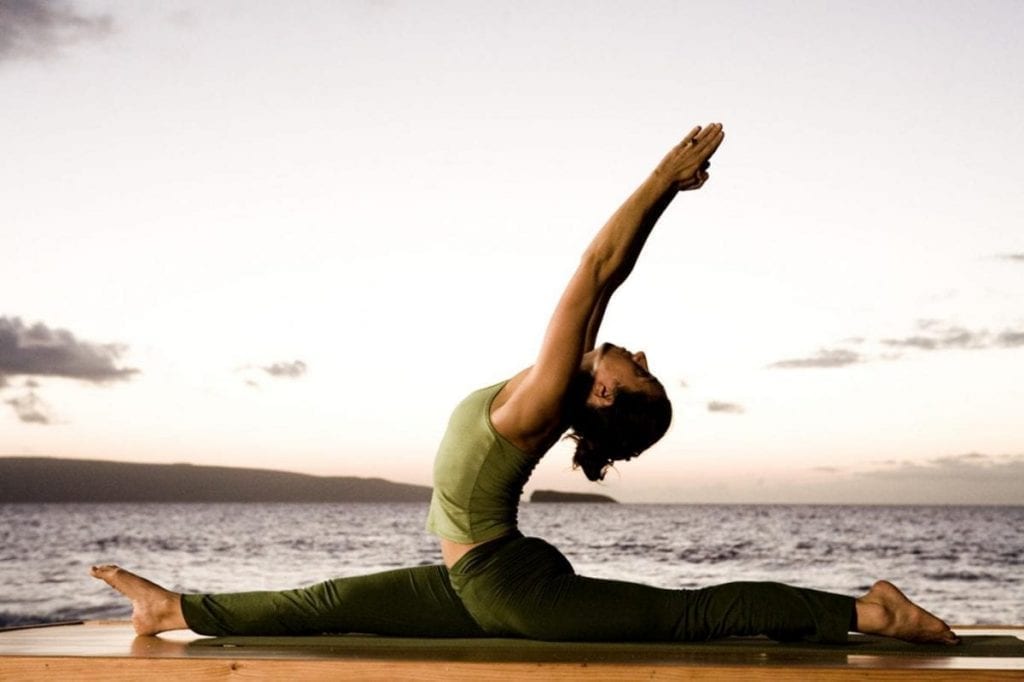
Benefits:
The posture of the board will improve your balance and strengthen your body’s muscles. It is an excellent posture for toning arms, legs and abs.
In addition, you will strengthen the lumbar musculature, improving the position of the spine.
This posture is especially recommended to relieve muscle tensions, insomnia and migraines.
Instructions:
- Stand by resting your hands and knees on the ground. Make sure your knees are aligned with your hips, and your hands aligned with your shoulders.
- Separate your fingers wide, keeping your palms rested on the ground.
- Now stretch your legs back, leaning on your toes and stretching your heels back.
- Stretch your arms, lift your chest and press your abs inwards, so that your whole body is in a straight line, like a board.
- Place your head facing the front and stay in this position for 5 long breaths.
- Return to the initial posture by gently lowering your knees to the ground.
4. Triangle posture (Trikonasana)

Benefits:
Triangle posture is one of the most common postures for yoga beginners. In this posture we manage to do hips, back, chest and shoulder muscles.
Strengthens thighs, calves and buttocks, improves spine flexibility and aligns shoulders correctly.
Relieves back pain, gastritis, indigestion, heartburn, flatulence.
It helps treat neck sprains, reduces stiffness in the neck, shoulders and knees and strengthens ankles and tones ligaments in the arms and legs.
It also stimulates the nervous system and relieves nerve depression, strengthens the pelvic area and tones reproductive organs.
Instructions:
- To begin, position yourself upright with your feet well apart and your knees shouldn’t bend.
- Rotate your right foot so that it is in the plane of your body and perpendicular to your left foot.
- Extend your arms sideways, parallel to the ground, palms down and extend the trunk to the right according to your comfort level, while the arms remain parallel to the floor.
- Once you have the trunk fully extended to the right, drop your right arm until your palm reaches your leg. Try to make it as low as possible, without flexing your legs.
- Now, extend your left arm upwards until it aligns with your right arm, forming a vertical line.
- Stretch your neck and turn your head to look up at the ceiling. Don’t turn your hips or shoulders, they should be on the same plane.
- Hold this position for 5 breaths.
- Keeping your arms outstretched, rotate the trunk to the upright position by force with your abs.
- Turn the right foot to the front, returning to the starting position.
- Now, repeat the posture but switch sides.
5. Tree posture (Vriksasana)
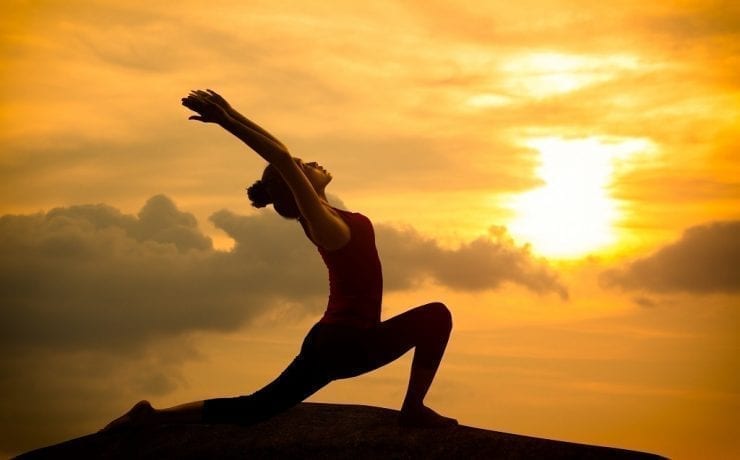
Benefits:
As a yoga beginner you should know the posture of the tree. This asana strengthens the spine, tendons, and ligaments in your feet. It also tones the muscles of your legs, knees and allows you to gain flexibility in your hips.
This posture is recommended when you have sciatica problems or flat foot problems, and in general, for disorders related to postural problems.
In addition, it provides peace of mind and increases your ability to concentrate.
Instructions:
- Stand, with your feet together and arms on your sides, extended downwards.
- Look ahead and keep your gaze and concentration at that point throughout the exercise.
- Now, rest your weight on your right foot, and slowly slide the sole of your left foot into the interior of your right leg, until you reach knee height. Keep your back straight
- Place the palms of your hands together with your fingers up at chest height, in the greeting position or Namaskar.
- Now, slowly raise your hands until you stretch your arms above your head.
- Stay in this position by breathing normally, between 5 and 10 breaths.
- As you exhale, lower your hands to your chest, returning to Namaskar posture.
- Return to the starting position.
- Repeat with your other leg
6. Warrior Posture 1 (Virabhadrasana I)
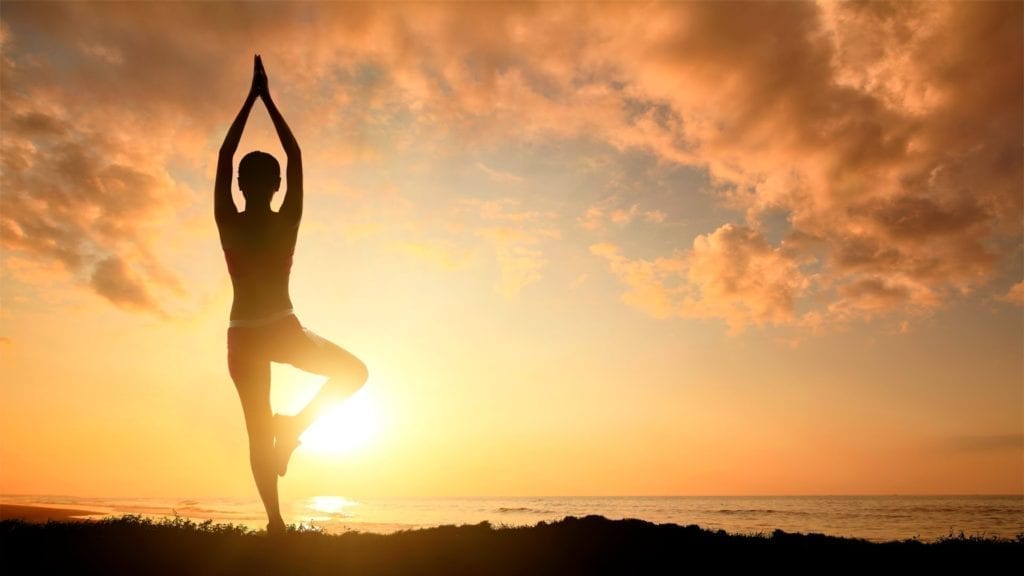
Benefits:
If you’re getting started in the world of yoga, you’ve probably heard of the warrior’s posture.
With this posture we manage to strengthen practically all the muscles of our body. In the lower body, buttocks, quadriceps, hamstrings and adductors. At the top, the muscles around the entire spine and abs.
By practicing the warrior I’s posture, you will significantly improve the functions your respiratory system and your blood circulation system.
Instructions:
- Stand, with your feet together and arms at the sides, extended down with your palms in front.
- Take your right foot back, well separated, fully supporting the sole of the foot.
- Bend your left leg slightly, until your knee is on the heel vertically, keeping your hips aligned facing the front.
- Raise your arms towards the ceiling, keeping your palms inward.
- Keep your back straight and look forward. Stay in this position breathing normally.
- Return to the starting position by stepping forward.
- Repeat the same exercise with the other leg
7. Warrior's Position 2 (Virabhadrasana II)
Benefits:
Warrior 2’s posture gives us the same benefits as the warrior’s 1 posture: muscle toning of our entire body and substantial improvement of our respiratory and circulatory systems.
Instructions:
- Stand, with your feet together and arms at the sides, extended down with your palms in front.
- Take your right foot back, well separated, fully supporting the sole of the foot. Just like in the warrior I’s posture.
- Now turn your hips to the right, leaving your right foot perpendicular to the left foot.
- Slightly bend your left leg, until your knee is on the heel vertically, keeping your hips aligned facing to the right.
- Extend your arms crossed, palms to the ground and keeping your shoulders relaxed.
- Stay in this position by breathing normally.
- Return to the starting position by stepping forward.
- Repeat the same exercise with the other leg.
8. Sitting clamp position (Paschimottanasana)

Benefits:
This posture gets us to strengthen the entire spine, activating the nerves in the spine.
Strengthens the muscles of our legs and abdomen.
Sitting clamp posture is beneficial for liver, kidneys, ovaries and uterus.
It relaxes the mind, relieves headache, eliminates stress and depression.
Paschimottanasana’s daily practice improves your digestive system and is beneficial for those suffering from insomnia.
Instructions:
- Sit with your backs straight and legs slightly bent, lifting your toes upwards.
- Now, slowly tilt your body forward until your chest reaches your thighs, keeping your back straight.
- With your hands, grab your feet with your palms, without bending your back.
- Try to stretch your legs to the point that it is comfortable, relaxing your shoulders.
- Hold this posture and breathe normally. As a beginner of yoga this is the best method. As you gain experience, you’ll be able to stretch your legs more and get the full clamp.
9. Bridge posture (Setu Bandha Sarvangasana)
Benefits:
With the bridge posture you will strengthen the muscles of the back, relieving any pain.
It is recommended for women in menopause and menstrual pains, as well as for people suffering from asthma, osteoporosis, sinusitis or high blood pressure.
Instructions:
- Lie on your back, with your arms outstretched to the sides, resting your palms on the floor and legs bent, with your knees together and your heels separated by a span of your buttocks.
- Now, while inhaling, slowly lift your back, from the lower back to the upper.
- Rest your shoulders on the floor and bring your chest to your chin, resting your weight with your shoulders, arms and feet.
- You can intertwine your fingers and push your hands against the ground or if you prefer, flex your elbows and rest the lower back in your hands.
- Hold the posture for 30 seconds or a minute.
- To finish, stretch your arms on the ground and while exhaling by slowly lowering your back to the ground. Stretch your legs one by one.
10. Child posture (Balasana)
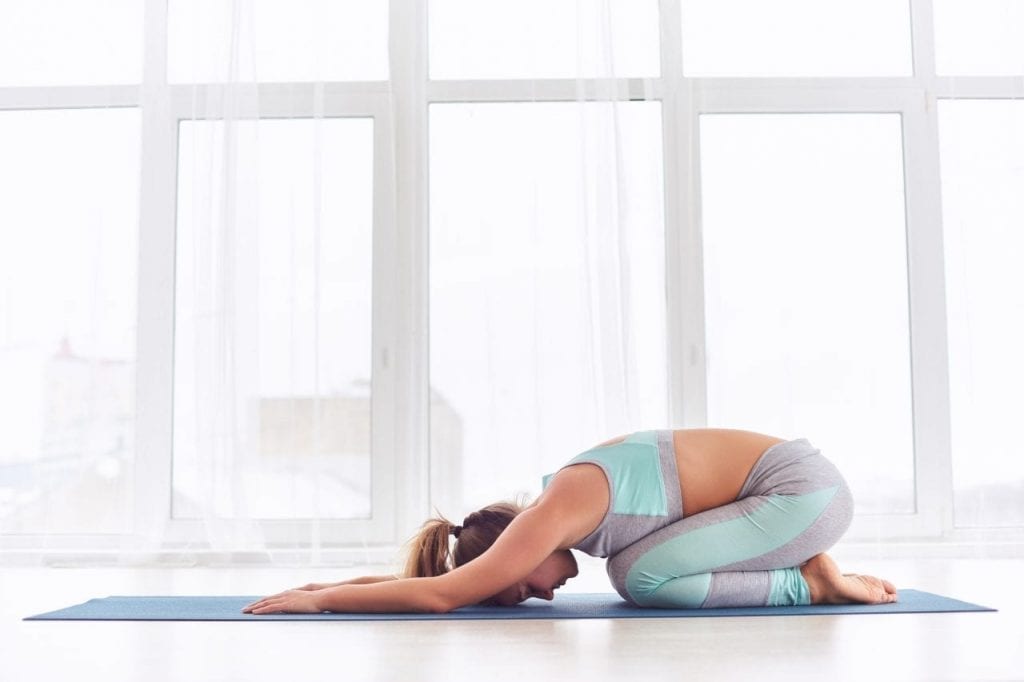
Benefits:
We all need a good resting posture and the child’s posture is amazing, not only for beginners but also for yoga practitioners of all levels.
This posture provides mental calm, allowing you to reduce stress and increase your ability to concentrate.
Instructions:
- Sit, with our back straight and legs stretched forward.
- Now, bend your legs to your buttocks and sit on your heels.
- Relax your thighs over your calves and place your feet so that your big toes touch each other.
- Rest your palms on the ground and keep your back straight.
- Tilt your body forward, placing your chin between your knees and rest your forehead on the ground.
- Put your hands behind your buttocks interlacing your fingers.
- Look for a comfortable position, relax all the muscles of your body and breathe slowly and deeply.
- Stay in this position for at least 2 minutes.
- Return to the starting position slowly.
It’s time to practice these yoga poses for beginners!
Enjoy your beginnings in this exciting world.
Contents



